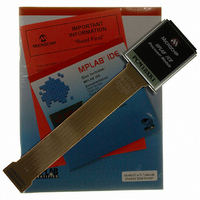PCM18XK1 Microchip Technology, PCM18XK1 Datasheet - Page 225

PCM18XK1
Manufacturer Part Number
PCM18XK1
Description
MODULE PROC PIC18F8680,6680,8565
Manufacturer
Microchip Technology
Datasheet
1.PCM18XK1.pdf
(496 pages)
Specifications of PCM18XK1
Accessory Type
Processor Module
Lead Free Status / RoHS Status
Not applicable / Not applicable
For Use With/related Products
ICE2000
For Use With
ICE2000 - EMULATOR MPLAB-ICE 2000 POD
Lead Free Status / Rohs Status
Lead free / RoHS Compliant
- Current page: 225 of 496
- Download datasheet (9Mb)
17.4.14
While in Sleep mode, the I
addresses or data and when an address match or com-
plete byte transfer occurs, wake the processor from
Sleep (if the MSSP interrupt is enabled).
17.4.15
A Reset disables the MSSP module and terminates the
current transfer.
17.4.16
In Multi-Master mode, the interrupt generation on the
detection of the Start and Stop conditions allows the
determination of when the bus is free. The Stop (P) and
Start (S) bits are cleared from a Reset or when the
MSSP module is disabled. Control of the I
be taken when the P bit (SSPSTAT<4>) is set or the
bus is Idle, with both the S and P bits clear. When the
bus is busy, enabling the SSP interrupt will generate
the interrupt when the Stop condition occurs.
In multi-master operation, the SDA line must be moni-
tored for arbitration to see if the signal level is the
expected output level. This check is performed in
hardware with the result placed in the BCLIF bit.
The states where arbitration can be lost are:
• Address Transfer
• Data Transfer
• A Start Condition
• A Repeated Start Condition
• An Acknowledge Condition
FIGURE 17-25:
2004 Microchip Technology Inc.
SDA
SCL
BCLIF
SLEEP OPERATION
EFFECT OF A RESET
MULTI-MASTER MODE
BUS COLLISION TIMING FOR TRANSMIT AND ACKNOWLEDGE
2
C module can receive
Data changes
while SCL = 0
2
C bus may
PIC18F6585/8585/6680/8680
SDA released
by master
SDA line pulled low
by another source
17.4.17
Multi-Master mode support is achieved by bus arbitra-
tion. When the master outputs address/data bits onto
the SDA pin, arbitration takes place when the master
outputs a ‘1’ on SDA by letting SDA float high and
another master asserts a ‘0’. When the SCL pin floats
high, data should be stable. If the expected data on
SDA is a ‘1’ and the data sampled on the SDA pin = 0,
then a bus collision has taken place. The master will set
the Bus Collision Interrupt Flag, BCLIF and reset the
I
If a transmit was in progress when the bus collision
occurred, the transmission is halted, the BF flag is
cleared, the SDA and SCL lines are deasserted and the
SSPBUF can be written to. When the user services the
bus collision Interrupt Service Routine and if the I
bus is free, the user can resume communication by
asserting a Start condition.
If a Start, Repeated Start, Stop, or Acknowledge condi-
tion was in progress when the bus collision occurred,
the condition is aborted, the SDA and SCL lines are
deasserted, and the respective control bits in the
SSPCON2 register are cleared. When the user ser-
vices the bus collision Interrupt Service Routine and if
the I
by asserting a Start condition.
The master will continue to monitor the SDA and SCL
pins. If a Stop condition occurs, the SSPIF bit will be set.
A write to the SSPBUF will start the transmission of
data at the first data bit regardless of where the
transmitter left off when the bus collision occurred.
In Multi-Master mode, the interrupt generation on the
detection of Start and Stop conditions allows the determi-
nation of when the bus is free. Control of the I
be taken when the P bit is set in the SSPSTAT register or
the bus is Idle and the S and P bits are cleared.
2
C port to its Idle state (Figure 17-25).
2
C bus is free, the user can resume communication
MULTI -MASTER COMMUNICATION,
BUS COLLISION AND
BUS ARBITRATION
Sample SDA. While SCL is high,
data doesn’t match what is driven
by the master.
Bus collision has occurred.
Set bus collision
interrupt (BCLIF)
DS30491C-page 223
2
C bus can
2
C
Related parts for PCM18XK1
Image
Part Number
Description
Manufacturer
Datasheet
Request
R

Part Number:
Description:
Manufacturer:
Microchip Technology Inc.
Datasheet:

Part Number:
Description:
Manufacturer:
Microchip Technology Inc.
Datasheet:

Part Number:
Description:
Manufacturer:
Microchip Technology Inc.
Datasheet:

Part Number:
Description:
Manufacturer:
Microchip Technology Inc.
Datasheet:

Part Number:
Description:
Manufacturer:
Microchip Technology Inc.
Datasheet:

Part Number:
Description:
Manufacturer:
Microchip Technology Inc.
Datasheet:

Part Number:
Description:
Manufacturer:
Microchip Technology Inc.
Datasheet:

Part Number:
Description:
Manufacturer:
Microchip Technology Inc.
Datasheet:










